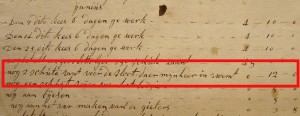Sport and recreation have always been an important part of bigger gardens and garden culture. Playing bowls, cricket, croquet, tennis, going out boating on the pond, even winter ‘games’ took place in the (larger) garden area.
All activities mentioned above come with their own set of materials or equipment to be able to recreate. The proper environment had also to be there: a pond for the boating, or a purpose-built lawn for the bowls game -the bowling green. Cricketers may have been less fussy about the quality of the grass than bowlers, provided it was kept short and there was enough space to bat (and catch) the ball.
Here I refer to an example of a type of recreation that is less obvious in a garden, and apparently doesn’t necessarily need any equipment at all: swimming.  At Huys ten Donck, it seems, the only thing they needed in 1766 was a ditch. This note was made in relation to swimming in june 1766 (click the image to enlarge). It is in Dutch, of course, and roughly translates as: “and 2 barges of sand for the ditch mylord swims in”. 1Stadsarchief Rotterdam, toegang 30 (archief Huys ten Donck), inv.nr. 1326. The note was written by head servant Pieter de Vos, listing costs made from March 1766 onwards (“rekenijng van de arrebeijders”). The reference to swimming is listed under June (“ijunius”) and reads: “nog 2 schute zant voer de sloot daer mijnheer in zwemt 0-12-0”.
At Huys ten Donck, it seems, the only thing they needed in 1766 was a ditch. This note was made in relation to swimming in june 1766 (click the image to enlarge). It is in Dutch, of course, and roughly translates as: “and 2 barges of sand for the ditch mylord swims in”. 1Stadsarchief Rotterdam, toegang 30 (archief Huys ten Donck), inv.nr. 1326. The note was written by head servant Pieter de Vos, listing costs made from March 1766 onwards (“rekenijng van de arrebeijders”). The reference to swimming is listed under June (“ijunius”) and reads: “nog 2 schute zant voer de sloot daer mijnheer in zwemt 0-12-0”.
The sand was probably used to keep the water from getting murky, as smaller soil particles would have been whirled up by ‘mylord’ Cornelis Groeninx van Zoelen’s swimming movements. The sand should have also kept waterplants from growing in the designated swimming water.
Cornelis Groeninx van Zoelen (1740-1791) was at the time in the process of changing the layout of his garden, at least partly laying out the garden in the landscape style in 1769. It is unclear whether that particular part of the redesigning process had already started in 1766. 2Heimerick M.J. Tromp, De Nederlandse Landschapsstijl in de Achttiende Eeuw (Leiden 2012), p233.
Of course, there are developments here as well, too far and wide to be described here. The swimming area was often accompanied by a bath house, even during the time of Huys ten Donck‘s simple solution.
But also later on, as this example shows: follow this link to find a photo of the old swimming pool at De Wildenborch, near Vorden, in the east of the country. This part of the garden dates back to the 1930s, according to the description of the garden in the national register of monuments. This swimming pool or ‘petit canal’ may have been a former ditch, transformed into a rectangular swimming pool with a simple structure at one end, containing two dressing rooms. Even a simple structure like that does not seem to have been present at Huys ten Donck in 1766 -at least: no description of a bath house or similar structure has survived.
Footnotes
| ↑1 | Stadsarchief Rotterdam, toegang 30 (archief Huys ten Donck), inv.nr. 1326. The note was written by head servant Pieter de Vos, listing costs made from March 1766 onwards (“rekenijng van de arrebeijders”). The reference to swimming is listed under June (“ijunius”) and reads: “nog 2 schute zant voer de sloot daer mijnheer in zwemt 0-12-0”. |
|---|---|
| ↑2 | Heimerick M.J. Tromp, De Nederlandse Landschapsstijl in de Achttiende Eeuw (Leiden 2012), p233. |


